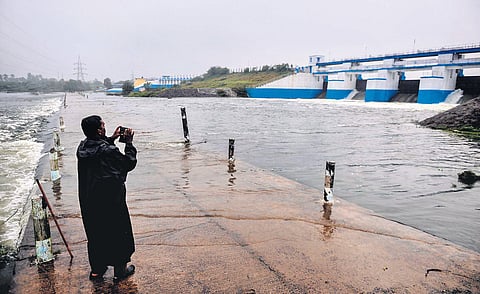

CHENNAI: Whenever she hears about the Chembarambakkam reservoir, V Kamala gets a haunting reminder of the 2015 deluge. When the shutters of the reservoir were opened that year, the Mudichur resident woke up to knee-deep water. Seconds later, water gushed into her house from all sides, destroying her belongings and leaving her crying for help.
“In the past 12 months, excess water was released from Chembarambakkam twice – in November 2020 and now. Though it has not caused flash floods this time, uncertainty over what may happen next, looms large,” said V Kamala. Failure to desilt Chembarambakkam lake over the years despite sanctioning of funds is one of the reasons why water had to be released on Sunday, say experts. Even last year, the government had made promises of desilting.
An official from the Public Works Department on condition of anonymity admitted at least 15 per cent of the lake is filled with silt and that deepening works had not been taken up. This accounts for nearly 550 mcft of water or 6,365 cusecs that has been going waste.
Following heavy rains since Saturday evening, the reservoir received a copious inflow, increasing water level to nearly 22 feet, against the total capacity of 24 feet. As much as 2,000 cusecs of water was released till Sunday afternoon. The same amount continues to be released from Poondi and Red Hills reservoirs. Officials also said they might release more water since rains are predicted in the coming days.
Built a century ago
The Chembarambakkam reservoir was constructed over a century ago, but proper desilting has never been done. A project began in 2019 to desilt Chembarambakkam and other three reservoirs (Red Hills, Poondi, Cholavaram) at a cost of around `36 crore. The desilting project was also expected to bring additional revenue with the sale of excavated sand.
Chembarambakkam alone was expected to generate `191 crore. The project duration was eight years to desilt the entire lake, which has a storage capacity of 3,645 million cubic feet (mcft). As much as 151.80 lakh cubic metres of silt was to be removed and transported through 25.30 lakh lorry loads. Work orders were sanctioned but the project never really took off.
Experts suggest deepening of the lake as an immediate measure. “In reality, more than one-third of the Chembarambakkam reservoir is filled with silt. Firstly, a survey to find the quantum and quality of silt has never been conducted by the government. So, nobody knows the exact amount of silt. What the government had done was to take a JCB and remove silt randomly. This only leaves pits inside the reservoir, which is more dangerous,” said S Janakarajan, a water management expert in the State.
He added that not even a drop of water would have been wasted if deepening and desilting had been done. “If not desilting, the government officials should have at least deepened the lake to restore its original capacity,” he said.
It would take at least a year to desilt the reservoir. Officials say since water has been bountiful in the rivers due to cyclones and good rains, they could not begin the work. However, Chennai always forgets to desilt its reservoirs and searches for water, when the rain gods aren’t so generous.
Current status
Chembarambakkam’s storage level as of Monday afternoon stood at 2,942 mcft (80.7% of total storage). Levels at Poondi, Cholavaram, and Red hills are 2,786 mcft, 908 mcft, and 2,916 mcft respectively.